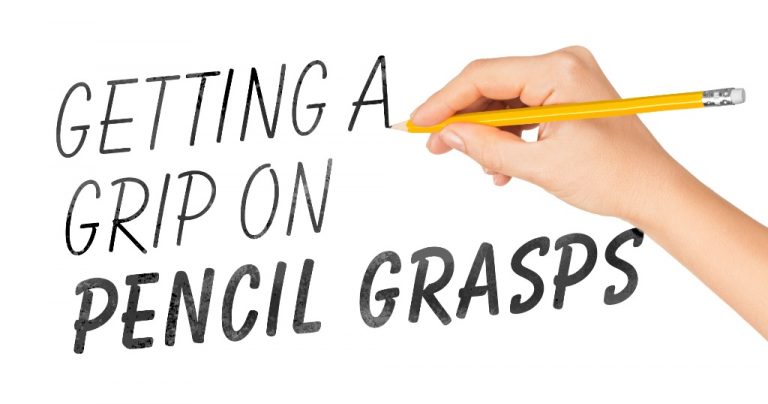
Getting a Grip on Pencil Grasps
By Corry O’Neill, MS, OTL
As your child develops, it’s important to keep in mind that the way they hold a pencil will also change. Normally, your child will have the correct pencil grip needed for handwriting when they are between 4-6 years old. Prior to this age, we need to make sure we’re taking the right steps to ensure the correct grasp patterns are developed. The dynamic tripod grasp is the holy grail of pencil grasps. The index finger and thumb on the pencil with the rest of the fingers against the palm with open webspace. Of course, there are other ways to hold a pencil that can be functional and efficient.
So, What Constitutes a Functional Grasp?
Let’s begin with normal hand development as this significantly impacts a child’s ability to hold a pencil correctly. Many activities affect hand development from lying on your stomach, crawling on hands and knees, and manipulating various sized items. “Tummy time” and crawling provide weight-bearing to the palms that help to integrate the palmar reflex (closing of the hand when an object touches it). Grasping various sized items also contributes to hand development – shaking a rattle works on wrist movements, picking up cheerios and feeding self helps to promote a pincer grasp (holding items between thumb and tip of index finger), stacking with blocks works on arm strength and stability and opening the space between finger and thumb (webspace), and holding a cup or pouring from one cup to another allows for both web space development and wrist motion.
As the hand develops typically, the ulnar side (pinkie side) becomes the “stabilizer” and the radial side (thumb side) is the “precision mover.” The ability to move the small joints of the fingers depends on the development of the small muscles of the hands. This finger movement puts the “dynamic” in the dynamic tripod. While these muscles are developing, children can be observed to use a variety of immature grasp patterns before developing a more refined tripod. These patterns can appear to be inappropriate but help to develop the more mature muscles and wrist movements needed for proper grasp patterns.
Some things to keep in mind: Typically, the strength and stability to hold a pencil “correctly” is not developed until at least 4 years of age. Prior to this age, it may be beneficial to use a larger diameter, shorter writing instruments, or very small, broken crayons to facilitate the use of the thumb and index finger. If a child is presented with a typical writing tool (pencil, pen, marker, regular-sized crayons) too early, there is a high likelihood that inefficient grasp patterns may develop to compensate for the lack of necessary muscle and motor coordination skills. Once these patterns are developed, they can be difficult to change.
Key components of functional grasp patterns include providing stability within the hand seen by the pinkie side of the hand stabilizing while allowing mobility of the fingers on the thumb side, space between the thumb and fingers (open web space), and the ability of fingers and hand to move separately from the arm and shoulder. These components allow for fluid movements to accurately form letters, color within small borders and draw small objects.
The problem with inefficient pencil grasps, those that demonstrate closed webspace, hyperextension of the thumb, and/or wrist flexion is they may not only impact the quality of written work but also have the potential to cause pain, fatigue with writing, and decreasing speed of writing. This impacts the ability to keep up with taking notes or the length of written work. When an inefficient grasp causes pain or fatigue, a child is less likely to want to write for extended periods.
What Do We Do?
To avoid this, it is important to try to correct inefficient grasps as early as possible. There are a number of different pencil grips available to promote better grasp patterns, but it is important to collaborate with the child to find one that works for them. A simple trick to promote hand separation for holding a pencil is to have the child hold an item with the ring and pinkie fingers without dropping it while performing a precision movement with the thumb side.
The following websites are good resources for activities promoting proper hand development:
- http://www.ot-mom-learning-activities.com/pencil-grasp.html
- http://mamaot.com/developmental-progression-of-pencil-grasp/
- https://www.playdoughtoplato.com/pencil-grasp-development-in-preschoolers/
- http://www.ot-mom-learning-activities.com/poor-pencil-grip.html
- https://www.otplan.com/articles/pencil-grasp-patterns.aspx
We’re Here to Help
Pediatric physical or occupational therapists can help with mobilization issues, muscle coordination and can instruct you or your child in exercises to strengthen your muscles to improve your overall movement. To request an appointment with one of our highly-trained physical therapists, click here!
The medical information contained herein is provided as an information resource only, and does not substitute professional medical advice or consultation with healthcare professionals. This information is not intended to be patient education, does not create any patient-provider relationship, and should not be used as a substitute for professional diagnosis, treatment or medical advice. Please consult with your healthcare provider before making any healthcare decisions or for guidance about a specific medical condition. If you think you have a medical emergency, call your doctor or 911 immediately. IvyRehab Network, Inc. disclaims any and all responsibility, and shall have no liability, for any damages, loss, injury or liability whatsoever suffered as a result of your reliance on the information contained herein.